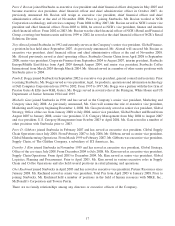Starbucks 2008 Annual Report Download - page 31
Download and view the complete annual report
Please find page 31 of the 2008 Starbucks annual report below. You can navigate through the pages in the report by either clicking on the pages listed below, or by using the keyword search tool below to find specific information within the annual report.
growth decelerated each quarter and comparable store sales declined each quarter, reflecting the ongoing
challenging economic conditions in the US.
The Company derived the remaining 16% of total net revenues from channels outside the Company-operated retail
stores, collectively known as specialty operations. Licensing revenues, which are derived from retail store licensing
arrangements as well as grocery, warehouse club and certain other branded-product operations, increased primarily
due to higher product sales and royalty revenues from the opening of 988 new licensed retail stores in the last
12 months. The increase in Foodservice and other revenues was primarily driven by growth in new and existing
accounts in the US foodservice business.
For fiscal 2009, the Company expects total revenues to be relatively flat compared to fiscal 2008, with variations
driven by the level of comparable store sales.
Fiscal Year Ended
Sep 28,
2008
Sep 30,
2007 % Change
Sep 28,
2008
Sep 30,
2007
% of Total Net
Revenues
Cost of sales including occupancy costs ........... $4,645.3 $3,999.1 16.2% 44.7% 42.5%
Store operating expenses
(1)
..................... 3,745.1 3,215.9 16.5 36.1 34.2
Other operating expenses
(2)
.................... 330.1 294.2 12.2 3.2 3.1
Depreciation and amortization expenses ........... 549.3 467.2 17.6 5.3 5.0
General and administrative expenses .............. 456.0 489.2 (6.8) 4.4 5.2
Restructuring charges ......................... 266.9 — nm 2.6 —
Total operating expenses ...................... 9,992.7 8,465.6 18.0 96.2 89.9
Income from equity investees ................... 113.6 108.0 5.2 1.1 1.1
Operating income ......................... $ 503.9 $1,053.9 (52.2)% 4.9% 11.2%
(1)
As a percentage of related Company-operated retail revenues, store operating expenses were 42.7% and 40.2%
for the fiscal years ended September 28, 2008 and September 30, 2007, respectively.
(2)
As a percentage of related total specialty revenues, other operating expenses were 20.5% and 20.8% for the
fiscal years ended September 28, 2008 and September 30, 2007, respectively.
As discussed in the Management Overview section above, many of the Company’s operating expenses are fixed in
nature. As a result, the softness in US revenues during fiscal 2008 impacted nearly all consolidated and US segment
operating expense line items when viewed as a percentage of sales, and pressured operating margins.
Cost of sales including occupancy costs increased primarily due to higher distribution costs and higher rent
expenses as a percentage of revenues. Store operating expenses as a percentage of Company-operated retail
revenues increased primarily due to higher payroll expenditures as a percentage of revenues coupled with
impairment provisions in the US business, primarily driven by the slowdown in projected store openings.
Depreciation and amortization expenses increased primarily due to the opening of 681 new Company-operated
retail stores in the last 12 months. General and administrative expenses decreased primarily due to lower payroll-
related expenses. Restructuring charges include asset impairment, lease exit and severance costs. These costs are
associated with the closure of underperforming stores in the US and Australia, and the rationalization of the
Company’s leadership structure and non-store organization. See Note 3 to the consolidated financial statements for
further discussion.
25
























